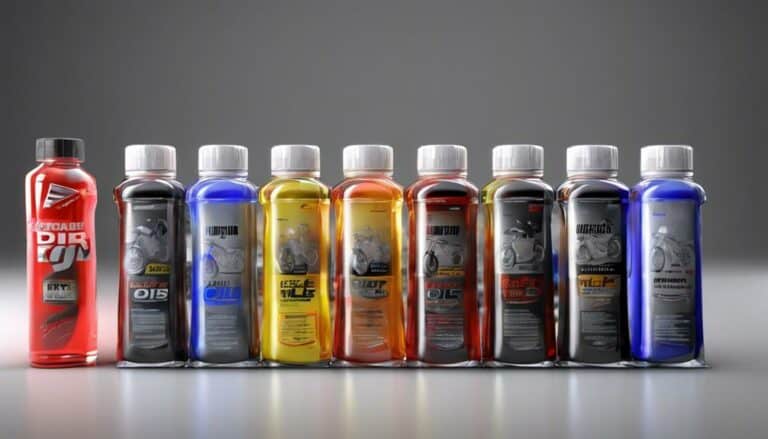When it comes to dirt bike engine oil, choosing the right viscosity is important. But do you know what the recommended viscosity is for your dirt bike?
The viscosity grade you select can greatly impact the performance and longevity of your engine. Stay tuned to uncover the key factors influencing viscosity selection and why using the correct grade can make a world of difference for your dirt bike's engine health.
Key Takeaways
- Choose 10W-40 oil for 4-stroke dirt bike engines.
- Opt for 10W-50 oil in high-performance dirt bike engines.
- Use 75W-90 transmission-specific oils for certain gearboxes.
- Follow manufacturer's recommendations for proper maintenance practices.
Importance of Choosing the Right Viscosity
Choosing the correct viscosity of engine oil is a critical decision that directly impacts the performance and longevity of your dirt bike's engine. Engine oils play a pivotal role in lubricating the motor, reducing friction, and preventing wear on important components. The right viscosity guarantees that the oil can flow effectively in a wide range of temperatures and engine conditions, providing adequate protection at all times.
For dirt bikes, the manufacturer's recommendations on viscosity are paramount for maintaining the engine's health. Using the wrong viscosity can lead to insufficient lubrication, overheating, and accelerated wear on engine parts. High-performance engines may require specific viscosities like 10W-50 to meet their demands under extreme conditions. By adhering to the recommended viscosity grade, you're safeguarding your engine against premature breakdown and ensuring consistent performance.
Understanding Viscosity Grades
In understanding viscosity grades for dirt bike engine oil, the numerical values like 10W-40 or 10W-50 serve as important indicators of the oil's performance characteristics in varying temperature conditions.
The first number, such as 10W, signifies the oil's flow in cold temperatures. Lower first numbers mean better cold flow.
The second number, like 40 or 50, indicates the oil's viscosity at operating temperatures. Higher second numbers suggest thicker oil.
Selecting the recommended viscosity grade is crucial for ensuring proper lubrication and safeguarding the engine under different circumstances. Opting for the right viscosity grade is essential for upholding top engine performance and longevity.
Factors Influencing Viscosity Selection
Factors influencing viscosity selection include the thickness and strength of the oil film in the engine, influenced by factors like load, temperature, and engine design. The ideal viscosity for dirt bike engine oil is determined by the ability of the oil film to withstand the mechanical stress caused by the engine's operation under varying conditions. Understanding the molecular constitution of the oil is important in selecting the right viscosity that can maintain the necessary lubrication. Quality indicators such as viscosity index and flash point play a significant role in predicting the oil's performance and durability. Here is a table summarizing the key factors affecting viscosity selection:
| Factors | Description | Influence on Viscosity Selection |
|---|---|---|
| Load | Magnitude of mechanical stress | Higher loads require higher viscosity oils for better protection |
| Temperature | Operating conditions | Viscosity should be selected based on the expected temperature range |
| Engine Design | Configuration of the engine | Different engine designs may require different viscosity oils for the best performance |
Understanding these factors will help you choose the most suitable viscosity for your dirt bike engine, ensuring efficient lubrication and engine longevity.
Recommended Viscosity for Dirt Bike Engines
When selecting the recommended viscosity for dirt bike engines, consider the specific requirements of your engine type and performance level. For most 4-stroke motors, a common choice is 10W-40 engine oil. However, if you have a high-performance engine, opting for 10W-50 oil can provide better lubrication and protection.
Additionally, certain gearboxes in dirt bikes may necessitate transmission-specific oils like 75W-90 to guarantee ideal performance and longevity. Always adhere to manufacturer recommendations regarding viscosity to guarantee proper maintenance of both the engine and transmission systems.
Tips for Maintaining Optimal Viscosity
Consider regular monitoring of oil levels and quality to uphold the recommended viscosity for ideal dirt bike engine performance and longevity.
Start by conducting routine oil level checks to verify proper lubrication and prevent potential engine damage. It's essential to use a high-quality oil within the recommended viscosity range to maintain peak engine performance.
Additionally, monitor the oil color and consistency for any signs of contamination or breakdown, which could impact the oil's viscosity. Adhere to the manufacturer's guidelines for oil change intervals to prevent viscosity issues and guarantee the engine operates smoothly.
When selecting oil, take into account the operating temperature and climate to choose the appropriate viscosity for your dirt bike. By following these tips for dirt bike maintenance, you can preserve peak viscosity levels, ultimately enhancing engine performance and extending the longevity of your bike.
Conclusion
To wrap up, ensuring you use the recommended viscosity for your dirt bike engine oil is essential for top performance and protection. By selecting the right grade, such as 10W-40, you can strike a perfect balance between cold flow and high-temperature film strength.
Remember to always follow the manufacturer's guidelines to keep your engine running smoothly and efficiently. Keep the wheels spinning and the engine purring like a well-oiled machine.

